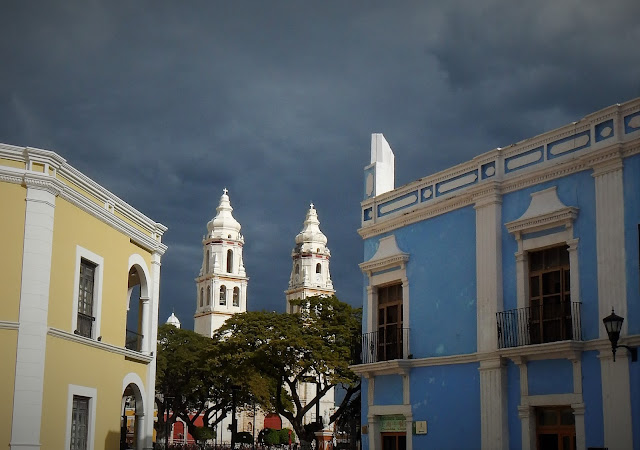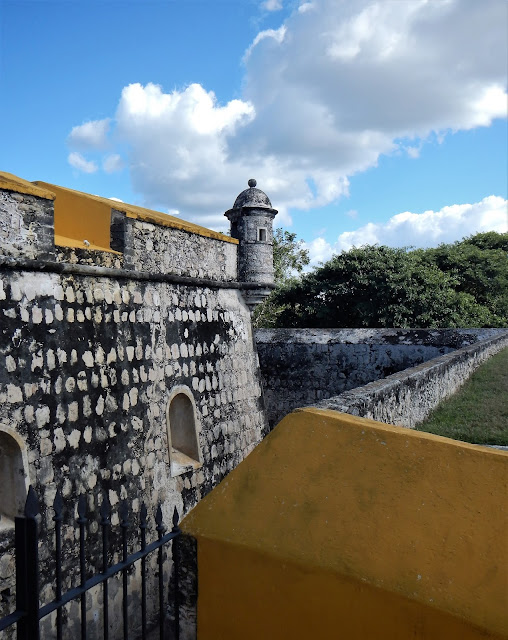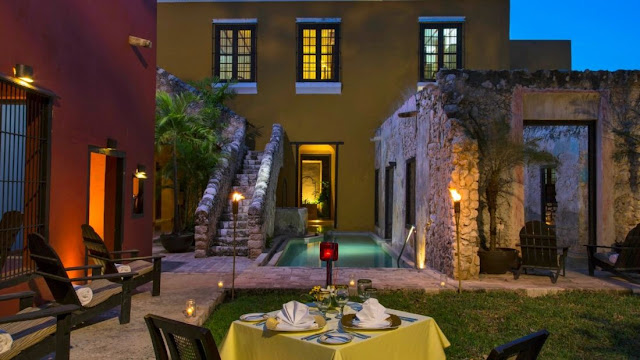Your beliefs don’t make you a free
thinker.
The ability to change your beliefs
based on new information does.
Anonymous
 |
Fuerte (fort) de San Jose el Alto. Entrance to fort on top of hill.
|
 |
| Cathedral
at end of colorful street. Very first mass in mainland America took place here. |
Today one
of the least populated Mexican states, Campeche (state) was once the site of a thriving
Mayan civilization. Campeche (town) was initially
the site of the Mayan City of Can-Pech (place of snakes and ticks/mites – not very
appealing name?) and conquered by Francisco de Montejo who established the city
in 1540, two decades after the conquest of Mexico City area. The other version is that Pech was the name of one of the most influential families of the time.
 |
Cathedral de Nuestra Señora de la Purisima Concepción
At night – well lit up.
By Ralf Roletschek.
|
 |
Storm brewing that day but nothing came of it.
|
 |
Moat, Fuerte San Jose el Alto
|
 |
Lookout tower, Fuerte San Jose el Alto
|
 |
Entrance Fuerte San Miguel at the other end of town
|
 |
Fuerte San Miguel, Lookout tower and cannon overlooking the
bay
|
 |
Lone cannon along the malecón
|
 |
Old church being renovated.
Pigeon inspecting.
|
 |
Playing street organ with a fake monkey on the upper left
corner
at Sunday market as promotion to bakery across the way.
Harmoni – Pan
|
 |
Campeche chair – from museum archive
|
 |
Couldn't find author or name for this one.
Used to have a real
net in his hands. I would call it
‘Broken flow’.
Must look great when the water fountain is running.
|
 |
Bride of the Sea on the malecón.
Legend is she fell in love with pirate (or sailor) and when
he left
she went to wait for him, and is still waiting.
|
 |
While parents are selling at the Sunday market,
kids playfully wait
|
 |
Fisherman by Puerta del Mar
|
 |
Water seller sculpture just outside the wall.
Campeche is filled with these gems all over town.
|
 |
| Where we had coffee, previously Hotel Cuauhtémoc (falling eagle) |
 |
Another coffee place, Sotavento (leeward)
|
 |
Now government office,
Mansión Carvajal used to be the farm house of a wealthy family
|
 |
The staircase to second floor
|
 |
Juliet balconies, iron street lights,
and egg-yolk yellow in many places (fort, churches, hotels,
homes).
I researched why this color but no one seems to know
why. Semblance of gold?
|
 |
Three types of woods,
two colors, one cheap chain, but a good lock
|
 |
Another empty space with blackboard,
a green fan with a black
bird on each blade, interesting layers of colors on wall.
|
 |
Inside one of the abandoned buildings.
Plants taking over.
Not once have we seen squatters.
|
 |
Green Presbyterian church with modern fountain in foreground
|
 |
Famous ‘pedestrian only’ Calle 59.
From where we were having hot chocolate
|
 |
Hacienda Puerta Campeche, using part of old stone walls
around swimming pool
|
 |
From same hotel – great integration of old and new (from
their website)
|
 |
Blue meets egg-yolk yellow
|
 |
Blood-red meets egg-yolk yellow
|
 |
Mike and Nikki in ‘Wonderland’.
Surrealistic cemetery entrance
|
 |
| Pop of color in an otherwise drab environment |
 |
Another pastel color in a sea of gray
|
Gorgeous pictures, Marie! Thanks for sharing your adventure with us. Hope Mike's training is going well! xo
ReplyDeleteThank you Beth. Loving it here. Only four weeks to the big event. All is going well....
Delete